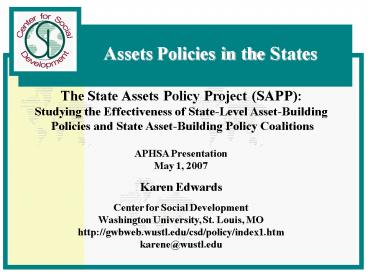The State Assets Policy Project SAPP: - PowerPoint PPT Presentation
1 / 12
Title:
The State Assets Policy Project SAPP:
Description:
Eearned Income Tax Credit (EITC) and VITA Sites. Financial Education ... (CDFIs) Non-predatory (Banking the 'un-banked' and 'underbanked'; credit repair) ... – PowerPoint PPT presentation
Number of Views:48
Avg rating:3.0/5.0
Title: The State Assets Policy Project SAPP:
1
The State Assets Policy Project (SAPP) Studying
the Effectiveness of State-Level Asset-Building
Policies and State Asset-Building Policy
Coalitions APHSA Presentation May 1, 2007 Karen
Edwards Center for Social Development Washington
University, St. Louis, MO http//gwbweb.wustl.edu/
csd/policy/index1.htm karene_at_wustl.edu
2
- The State Assets Policy Project (SAPP)
- Began in 1999 with a grant from the Ford
Foundation - Tracking state IDA policy activity and
publishing information (web page) - Expanded in 2001 - additional funding from the
C. S. Mott, Annie E. Casey, Ewing Marion
Kauffman, and Levi Strauss Foundations - Researching state IDA policy trends and
inclusive features - Expanding focus beyond IDAs to include
additional asset-building policies - Hosting an annual State Assets Policy
Conference in St. Louis - Publishing research and policy briefs on related
topics - Provide state policymakers and advocates with
expert advice
3
Selected Asset-Building Policies Utilized by
Individuals and Families with Low Incomes
Inclusive?
- Earned Income Tax Credit - 1975
- Assets for Independence Act (AFIA) - IDAs -
1998
- Social Security Act of 1996 PWRORA, Section
404(h) TANF IDAs
- Federal Home Loan Bank Affordable Housing
Program Initiative-1995
- HUDs FSS Escrow Accounts-1996, homeownership
vouchers, and CDBG
- Workforce Investment Act Individual Training
Accounts (ITAs) - 1996
- College Savings Plans (529s) with matching
components (5 states)-1996
- SSI PASS Accounts - 1985
4
- Inclusive Assets Policy Options for States
- IDAs and other matched savings programs
(College Savings Medical Savings Retirement
Savings) - Eearned Income Tax Credit (EITC) and VITA Sites
- Financial Education
- Alternative Banking Institutions (CDFIs)
Non-predatory (Banking the un-banked and
underbanked credit repair) - Homeownership Programs and Trusts
- Small and Micro-Business Development
5
State IDA Policy 1991-2007
- 23 states support IDAs (plus D.C.) 35 states
have some type of IDA policy
- Most bills were bipartisan and passed between
1997 and 2000
- IDAs included in federal welfare reform law of
1996
- 30 states include IDAs in welfare (TANF) plans
- 500 community-based IDA programs in all 50
states (20,000 accounts) including 15 IDA
programs in Native American communities
- 30 states have developed asset-building
coalitions or task forces
- AFIA passed in 1998, used as funding for 20
state-supported programs
6
- Inclusive State Assets Policy What Might It
Accomplish? - Establish a higher level of state government
support for asset building. - Create a framework for asset building as a part
of a U.S. welfare system. - Encourage state funding for asset building for
people at all income levels. - State assets support and funding may leverage
other funding and support. - Flexible policy creates potential for asset
building for all populations. - Allow for potential portability of accounts.
- Set the stage for more inclusive federal
asset-building strategies. - Connect to existing federal assets policies.
7
- What do existing state assets coalitions do?
- Bring diverse groups of people together
(communities, - non-profits, government, financial institutions,
business, trade - associations, non-profit intermediaries and
advocacy groups) - Develops an asset-building strategy (policy and
programs) - Provide technical assistance and networking
opportunities - May raise and/or provide some funding for the
whole group - Determine research agenda and provide research
- opportunities for the whole group
- Create power through numbers.
8
- The assets policy and asset-building coalitions
connection - Examples of Particularly Active Coalitions
- Arizona
- California
- Illinois
- Louisiana-Mississippi-Arkansas-Texas
- New Mexico
- North Carolina
- Oregon
- Task Force Reports
- Delaware 5) Hawaii
- Pennsylvania 6) North Carolina (forthcoming)
- Michigan 7) Oregon (forthcoming)
- California
9
Policy Goals for Coalitions Going to Scale
- Develop Long-term, progressive, inclusive,
federal and state asset-building policies, with
dedicated funding and a universal delivery
systems, that include
- Sustainable and complementary funding sources
- Flexibility between state and federal
asset-building policies
- Asset accounts that begin at birth and are more
highly subsidized for low-income
individuals and families
- Favorable tax policies for employers that
accommodate matches for low-income individuals
and families
- A universal savings system (complimentary
policies that help people save and build assets)
10
Selected State IDA Policy Resources
- Center for Social Developments web page
http//gwbweb.wustl.edu/csd - go to State Assets
Policy from the main menu (Publications one
option)
- Edwards Mason, (2003). State Policy Trends
for Individual Development Accounts in the United
States, 1993-2003, CSD
- Grinstein-Weiss, Schreiner, Clancy, Sherraden,
(2001). Family Assets for Independence in
Minnesota Research Report, CSD.
- King, Edwards, Hicks, Larson (2003). American
Indians Tribal Communities and Individual
Development Account (IDA) Policy, Report, CSD. - Warren Edwards (2005). Status of State
Supported IDA Programs in 2005, CSD.
11
Selected Publications and Resources
- Parrish, McCulloch, Edwards, and Gunn (2006).
State Policy Options for Building Assets, New
America Foundation and CSD. Can be found at
http//gwbweb.wustl.edu/csd/Publications/2006/Stat
e_Policy_Options.pdf
- Stein Friedman (2003). Childrens
Development Accounts The Oregon Story, CSD.
- Greenberg Patel (2006). Coordinating
Individual Development Accounts and the Workforce
Investment Act to Increase Access to
Postsecondary Education and Training, CSD.
- Edwards Bailey (2006). State-level Individual
Development Account (IDA) Policy Opportunities
and Challenges for Rural Areas, CSD. - Shreiner, Clancy, Sherraden (2002). Savings
Performance in the American Dream Demonstration,
Final Report, CSD.
12
Web-Based State and Other Asset-Building Resources
Special Report Promoting Economic Security for
Working Families State Asset-Building
Initiatives, Heather McCulloch, Fannie Mae
Foundation, July 2005 http//content.knowledgeplex
.org/kp2/cache/documents/106925.pdf
Task Force for Working Families Commonwealth of
Pennsylvania--Department of Banking http//www.ban
king.state.pa.us/banking/cwp/view.asp?a1344Q546
115bankingNav Governors Task Force for
Financial Independence State of
Delaware http//www.state.de.us/governor/publicati
ons/financial_independence_final_report.pdf
New America Foundation http//www.assetbuilding.or
g/AssetBuilding/ CFED http//www.cfed.org
WID http//www.wid.org/publications/?pageequity































